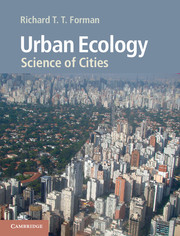Book contents
- Frontmatter
- Dedication
- Contents
- Foreword
- Preface
- Acknowledgments
- Part I Framework
- Part II Ecological features
- 4 Urban soil and chemicals
- 5 Urban air
- 6 Urban water systems
- 7 Urban water bodies
- 8 Urban habitat, vegetation, plants
- 9 Urban wildlife
- Part III Urban features
- Epilogue
- Appendix A Positive and negative attributes of an urban region
- Appendix B Equations
- References
- Index
7 - Urban water bodies
Published online by Cambridge University Press: 05 June 2014
- Frontmatter
- Dedication
- Contents
- Foreword
- Preface
- Acknowledgments
- Part I Framework
- Part II Ecological features
- 4 Urban soil and chemicals
- 5 Urban air
- 6 Urban water systems
- 7 Urban water bodies
- 8 Urban habitat, vegetation, plants
- 9 Urban wildlife
- Part III Urban features
- Epilogue
- Appendix A Positive and negative attributes of an urban region
- Appendix B Equations
- References
- Index
Summary
There are no fixtures in nature.
The universe is fluid and volatile.
Ralph Waldo Emerson, Circles, 1841
Ye nymphs that reign o’er sewers and sinks,
The river Rhine, it is well known,
Doth wash your city of Cologne;
But tell me, nymphs, what power divine
Shall henceforth wash the river Rhine?
Samuel Taylor Coleridge, The City of Cologne, 1800
Virtually all cities began by a water body. After centuries or decades of expansion, today a city can claim lots of urban water bodies of many types. We now dive into six key topics: (1) urban wetlands and ponds; (2) constructed basins, ponds, wetlands, biofilters; (3) urban streams; (4) urban rivers; (5) flooding by river and stream; and (6) urban coastal zones.
Wetlands
The types and definitions of wetlands vary widely. We refer to wetlands as vegetation-covered areas where water is at or above the ground surface for an extended period most years (Keddy, 2000; Marsh, 2005; Mitsch and Gosselink, 2007). Such a water regime produces three major characteristics of wetlands:
Hydrology – water in sufficient quantity flows into and maintains the wetland.
Soil – wetland soil is often saturated, contains considerable organic matter, and mainly exhibits anaerobic decomposition.
Vegetation – plants adapted to wet soil predominate.
- Type
- Chapter
- Information
- Urban EcologyScience of Cities, pp. 175 - 204Publisher: Cambridge University PressPrint publication year: 2014
- 1
- Cited by



